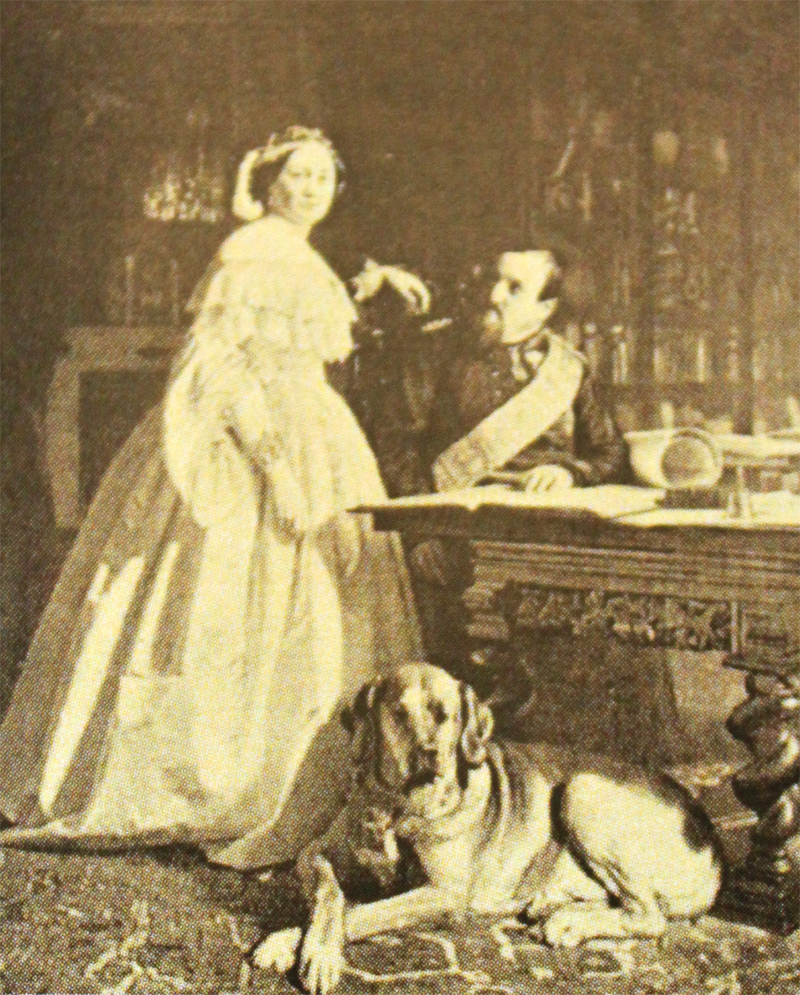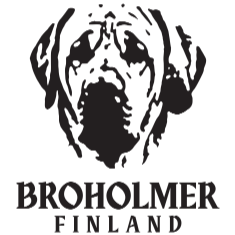Broholminkoirien historia Tanskassa





Broholminkoira tunnettiin jo keskiajalla Gudmen pikkukylässä Fynin saarella sijatsevassa Broholmin linnassa. Alun perin tanskalaiset koirat olivat kuitenkin melko pieniä ja pystykorvatyyppisiä, minkä vuoksi rodun mastiffityyppisten esi-isien uskotaan saapuneen maahan ryöstöretkillä olleiden viikinkien mukana Britteinsaarilta noin 700–1000-lukujen aikoihin.
Teoriaa tukee vahvasti se, että vanhasta viikinkikylästä löydetty koiran luuranko muistuttaa muodoltaan nykyistä broholminkoiraa. Toisessa entisessä viikinkimaassa Ruotsissa oli kehittynyt omaksi rodukseen nyt jo sukupuuttoon kuollut mastiffi taalainmaankoira, mikä myös antaa olettaa viikinkien vieneen englantilaisia mastiffeja kotimaihinsa.
Näitä englantilaisperäisiä mastiffeja risteytettiin myöhemmin (englannin)mastiffien ja tanskandoggien kanssa. Se on koko olemassaolonsa ajan toiminut kodinvahtina, mutta alun perin se myös vartioi ja ajoi karjaa. Rotu oli puhdas jo 1700-luvulla ja 1800-luvulla se ei ollut vielä ollenkaan harvinainen rotu, eikä varsinkaan Kööpenhaminassa. Koiria näkyi usein makoilemassa teurastajien liikkeiden edessä, mistä johtui parin vuosisadan takainen nimitys teurastajankoira. Sillä ei siis ole mitään tekemistä rodun luonteen kanssa, sillä se on ystävällinen ja rauhallinen.
Rotua käytettiin myös metsästykseen 1600-luvulla. Se saavutti Tanskan kuninkaallisten suosion, mutta sen kanta romahti nopeasti kun parimetsästys kiellettiin. 1800-luvun lopulla käyttöön tuli tanskalainen nimitys broholmeren kuninkaan riistanvartijana toimineen Broholmin kreivin Niels Frederik Bernhard Sehestedin mukaan. Rodun elvyttäminen oli hänen ansiotaan, ja hän aloitti sen etsien oikeanlaisia rodun edustajia eri puolilta maata. Moni sai häneltä koiran ilmaiseksi, jos lupasi kasvattaa pentueen.
Rodun kuuluisimpiin harrastajiin lukeutuivat muun muassa kreivitär Danner ja hänen puolisonsa Kuningas Fredrik VII. Eläimen sukupuolesta riippumatta kreivittären koirien nimi oli aina Holger ja kuninkaan koirien Tyrk.
Vuonna 1886 järjestettiin ensimmäinen tanskalainen koiranäyttely, jossa kreivi Sehestedin perilliset sopivat keskenään broholminkoiran rotumääritelmästä ja kirjasivat sen ylös. FCI käytti tuota samaa kuvausta hyväksyessään rodun viimein vuonna 1982, vaikka se oltiin rekisteröity tanskalaisiin jalostuskirjoihin jo vuodesta 1887.
Jalostusohjelman myötä broholminkoiria kasvatettiin myös Kööpenhaminan eläintarhassa vuosina 1859–1921, minkä aikana siellä syntyi peräti 200 pentua. Samanaikaisesti Tivoli-huvipuistossa mustia yksilöitä käytettiin vahtikoirina. Rotua uhkasi sukupuutto myös 1900-luvun alussa virusten ja sisäsiitoksen myötä. Vielä vuonna 1939 broholminkoiria tavattiin näyttelyissä, mutta toinen maailmansota oli viimeinen niitti rodun katoamiselle.
Tanskan kennelliitto julkaisi vuonna 1974 artikkelin jo lähes sukupuuttoon kuolleesta broholminkoirasta. Siihen vastasi 11-vuotiaan rekisteröimättömän uroksen omistaja, joka sai rodun kriittisen tilanteen vuoksi luvan ilmoittaa koiransa näyttelyihin nimellä Gamle Bjørn Fra Helsinge. Uros sai tuomarit vakuuttuneiksi siitä, että se oli juuri oikeantyyppinen yksilö. Julkisuuden ansiosta osa Kööpenhaminan eläintarhassa aiemmin kasvatettujen koirien jälkeläisistä löydettiin ja rotu saatiin elvytettyä.
Lataa tästä englanninkielinen juhlanumero broholminkoirista
Broholminkoirien historia Suomessa
Suomen ensimmäinen broholminkoira oli musta Saxo-uros. Saxo tuli Tanskasta Suomeen 1900-luvun lopulla, sillä ei ole teetetty jälkeläisiä.
Ensimmäiset jälkeläisiä saaneet nartut ovat Embla (Suomen ensimmäinen pentue 2005 ja toinen vuonna 2006) ja Fricka (pentue vuonna 2007). Kolmas tuontinarttu Lumo teki pentueen vuonna 2010. Suuri osa Suomessa syntyneistä broholminkoirista polveutuvat näistä kolmesta kantaemästä ja neljän eri uroksen spermasta. Pentueiden tiedot löytyvät Koiranetistä.
Koska Suomen kanta on hyvin kapealla jalostusmateriaalilla tuotettu, oli hyvin tärkeää saada Suomeen lisää uusia, sertifioituja, erisukuisia broholminkoiria. Pyrimme jakamaan tärkeää tietoa tästä ihanasta rodusta ja yritämme vaikuttaa siihen, että rotu säilyy tulevaisuudessa terveenä ja hyväluonteisena.
Kesällä 2011 Suomeen muutti Tanskasta uros Pluto. Keväällä 2013 Suomeen on muuttanut kansainvälisen yhteistyön ansiosta neljä uutta sertifioitua pentua, urokset Thor ja Nicke sekä nartut Liten ja Hilda. Thor ja Liten olivat Suomen ensimmäiset mustat broholminkoirat.
Väri on harvinainen myös kansainvälisesti ja maailmassa on arviolta alle 100 mustaa yksilöä, joista suurin osa asuu Tanskassa. Kesän 2013 lopulla Suomeen muutti Ruotsista neljä koiraa; Helga, Grethe, Max ja Gusse. Vuoden 2013 lopulla Suomeen muutti vielä yksi uros Tanskasta, Baloo.
Vuoden 2014 aikana Suomeen on muuttaneet sisarukset Loki ja Bonnie Tanskasta, Blenda Hollannista ja Chevy Norjasta. Vuonna 2015 Suomeen muutti kolme koiraa, Carlo Puolasta, Akke Ruotsista ja Nenna Tanskasta. Viideskymmenes tuontipentu muutti Suomeen Broholmer Finland ry:n avukstuksella vuonna 2020. Lisätietoja Suomeen muuttaneista pennuista löytyy tuontikoirien sivuilta ja Koiranetistä.

Broholminkoirien esiintyvyys
Broholminkoiria on nykyisin Tanskan lisäksi muun muassa Suomessa, Ruotsissa, Norjassa, Saksassa, Puolassa, Alankomaissa, Unkarissa, Sveitsissä ja Italiassa. Tästä huolimatta peräti 90 % noin 1500–2000 koiran populaatiosta elää kotimaassaan eikä koiria olla viety ulos maasta ennen vuotta 1998. Tämä johtuu osittain tiukoista jalostussäännöistä. Suomessa elää arviolta noin 150–200 broholminkoiraa.
Suomessa vuoden 2016 loppuun mennessä syntyneitä pentueita ei ole hyväksytetty Tanskan Broholmeryhdistyksellä, eivätkä ne ole saaneet tanskalaista rekisterinumeroa tai sertifikaattia, joka takaa sen, että koirat ovat jalostettu rodun alkuperämaan sääntöjen mukaisesti. Tähän asiaan pyritään saamaan muutos ja mm. Broholmer Finland ry jakaa aktiivisesti tietoa alkuperämaan Tanskan ohjeistuksista rodun jälleenrakennukseen liittyen.
Suomessa syntyntyneiden tanskalaiset ja JTO:n sekä Pevisan voimaantulon jälkeen myös suomalaiset jalostuskriteerit täyttävien pentueiden tiedot löydät nettisivuiltamme.

History
DANMARKS HAVE
Fyn is a small Danish island situated between Jutland and Sjælland. The western coast is separated from the mainland by the Lille Bælt (Little Belt) and the eastern coast by the Store Bælt (Great Belt). The capital is Odense, hometown of Hans Christian Andersen. Fyn has a charming landscape, green fields and grasslands, farmhouses with thatched roofs, and wooded hills. In between are little villages, old towns on the seaside, country houses and castles – one of the reasons Fyn is called Danmarks Have (Garden of Denmark). The small village of Gudme is situated between the city of Svendborg in the south and Nyborg in the east. There we can find a castle – maybe manor house is a better description – dating from the Renaissance and situated on the very small island of Broholm.
DANISH AND NORWEGIAN VIKINGS
It’s believed Danish and Norwegian Vikings who organized marauding expeditions to the British Isles from the 8th to the 11th century took Mastiff-like dogs home with them to Scandinavia, as stolen goods.
A dog skeleton found by archaeologists in an old Viking village on the island of Fyn had the form and shape of the Broholmer dog of today. Because local dogs in that time were far smaller and of a Spitz type, the theory about the Viking dogs is considered correct.
Additional proof is the so-called ‘Dalbo dog,’ also a Mastiff type. This type of dog lived in Sweden until the end of the 19th century – another reason the Broholmer is considered a distant descendant of the dogs the Vikings took home with them ages ago.
BUTCHER’S DOG
The descendants of the Viking dogs were crossbred with Great Danes and English Mastiffs, the latter presented to the Danish Court by King James I (1566-1625) of England. In those times, the Danish Mastiff-like dogs were used for herding and guarding cattle – on farms and at the cattle markets in the cities – and protecting hearth and home. A Danish dog book, published around 1800, states that the Broholmer was a very ordinary breed, not rare at all, especially in Copenhagen. His nickname was “butcher’s dog,” probably because one could see this type of dog lying on the doorsteps of butcher shops.
COUNT SEHESTED AND KING FREDERIK VII
During the 17th century, this Danish mastifflike dog was also a pack hound, especially used on royal hunting-grounds. After the ban on parforce hunting, their numbers dropped rapidly. Count Niels Frederik Bernhard Sehested (1813-1882), gamekeeper of the Danish King, archaeologist and living at Broholm Castle, started a breeding program to save the breed. During his travels throughout the country, he tried to find as many good examples of Broholmer dogs as possible, and gave a number of people a dog for free, providing they would breed a litter.
The name of the breed, Broholmeren in Danish – a tribute to the man who saved this dog from extinction – dates from the end of the 19th century. King Frederik VII (1848-1863) and his wife, Countess Danner, were great fanciers of the Broholmer. The royal couple owned these dogs for years. Those belonging to the king were always named ‘Tyrk’; Countess Danner’s were always ‘Holger,’ whether it was a dog or a bitch.
BREEDING BROHOLMERS IN THE ZOO
The first dog show in Denmark was organized in 1886. Descendants of Count Sehested met there, to write a breed standard. Broholmers have been recorded in the Danish stud books since 1887; in 1982, the breed was officially recognized by the FCI, which used the description from 1886, the only difference being acceptance of the colour black.
Between 1859 and 1921, Broholmers could be seen in the Copenhagen Zoo as part of a breeding program; about 200 puppies were born there. During this period, black Broholmers were used as guard dogs in the Tivoli Gardens, Copenhagen’s famous amusement park. Still it was not possible to save the Broholmer. Its numbers dropped dramatically because
of inbreeding, distemper and viral infections. There were some registrations in 1910, and Broholmers were entered at a dog show around 1939, but at the outbreak of World War II, the breed was finished.
FOLLOWING THE TRACK OF THE BROHOLMER
In 1974, the Danish Kennel Club published ‘Following the track of the Broholmer’ in its paper. Somebody from Sjælland, who owned an 11- year-old male without a pedigree, responded. He was given permission to enter the dog at a show under the name Gamle Bjørn Fra Helsinge (Old Bjørn from Helsinge).
The judges were in complete agreement: this dog was a real Broholmer! Thanks to a great deal of publicity, more representatives of the breed were traced, descendants of the dogs bred in the zoo some 50 years before. The 25th anniversary of the Broholmerselskapet was celebrated in 1999 with a show at which more than 100 Broholmers were entered.
Today there are about 1500 Broholmers, most of them living in Denmark. Breeding is done according to strict rules and only since January 1998 has the breed been exported, in very small numbers. Broholmers in front of the manor house Langesoe, on the island of Fyn. Broholm Castle, Count Sehested’s home on the island of Fyn, ca. 1930. A retired bookseller and publisher, Ria Hörter is a contributing editor of De Hondenwereld, the national dog magazine of Holland.


